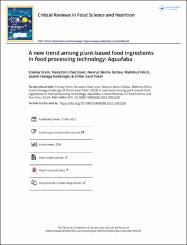| dc.contributor.author | Erem, Erenay | |
| dc.contributor.author | İçyer, Necattin Cihat | |
| dc.contributor.author | Tatlısu, Nevruz Berna | |
| dc.contributor.author | Kılıçlı, Mahmut | |
| dc.contributor.author | Hülağa Kaderoğlu, Gizem | |
| dc.contributor.author | Toker, Ömer Said | |
| dc.date.accessioned | 2023-08-12T07:19:40Z | |
| dc.date.available | 2023-08-12T07:19:40Z | |
| dc.date.issued | 2023 | en_US |
| dc.identifier.issn | 1040-8398 | |
| dc.identifier.issn | 1549-7852 | |
| dc.identifier.uri | https://hdl.handle.net/11363/5269 | |
| dc.description.abstract | In the new century, the most fundamental problem on a global scale is hunger and poverty
reduction is one of the primary goals set by the United Nations. Currently, it is necessary to
increase agricultural activities and to evaluate all agricultural products rich in nutrients without
loss in order to feed the hungry population in the world. Considering that one of the most
important causes of hunger in the world is inadequate access to protein content, legumes are
one of the most valuable nutritional resources. In order to ensure the sustainability of legumes,
alternative new ways of recycling their wastes are sought based on these multiple functions. For
this purpose, recycling legume cooking waters to be used as food raw materials in various processes
means reducing food waste. Recovery of nutritional components in legumes is also beneficial in
vegan and vegetarian diets. In this review study, the importance of legumes in terms of global
needs, their importance in terms of nutrition, the methods of obtaining the protein content of
legumes, the functional properties of these proteins in the field of food processing, the gains of
the evaluation and recovery of legume cooking water (Aquafaba), especially waste, were discussed. | en_US |
| dc.language.iso | eng | en_US |
| dc.publisher | TAYLOR & FRANCIS INC, 530 WALNUT STREET, STE 850, PHILADELPHIA, PA 19106 | en_US |
| dc.relation.isversionof | 10.1080/10408398.2021.2002259 | en_US |
| dc.rights | info:eu-repo/semantics/openAccess | en_US |
| dc.rights | Attribution-NonCommercial-NoDerivs 3.0 United States | * |
| dc.rights.uri | http://creativecommons.org/licenses/by-nc-nd/3.0/us/ | * |
| dc.subject | Aquafaba | en_US |
| dc.subject | legumes protein | en_US |
| dc.subject | sustainable production | en_US |
| dc.subject | waste recycling | en_US |
| dc.title | A new trend among plant-based food ingredients in food processing technology: Aquafaba | en_US |
| dc.type | article | en_US |
| dc.relation.ispartof | Critical Reviews in Food Science and Nutrition | en_US |
| dc.department | Uygulamalı Bilimler Fakültesi | en_US |
| dc.authorid | http://orcid.org/0000-0002-1607-2610 | en_US |
| dc.authorid | http://orcid.org/0000-0002-3190-9669 | en_US |
| dc.authorid | http://orcid.org/0000-0001-7460-1560 | en_US |
| dc.authorid | http://orcid.org/0000-0002-6885-0277 | en_US |
| dc.authorid | http://orcid.org/0000-0001-6722-1519 | en_US |
| dc.authorid | http://orcid.org/0000-0002-7304-2071 | en_US |
| dc.identifier.volume | 63 | en_US |
| dc.identifier.issue | 20 | en_US |
| dc.identifier.startpage | 4467 | en_US |
| dc.identifier.endpage | 4484 | en_US |
| dc.relation.publicationcategory | Makale - Uluslararası Hakemli Dergi - Kurum Öğretim Elemanı | en_US |
| dc.contributor.institutionauthor | Tatlısu, Nevruz Berna | |
| dc.contributor.institutionauthor | Hülağa Kaderoğlu, Gizem | |



















